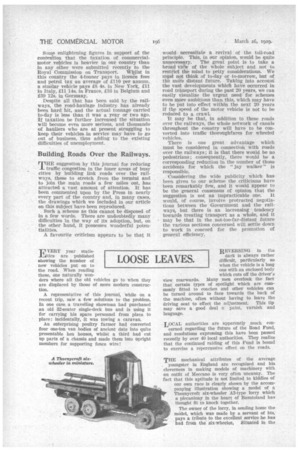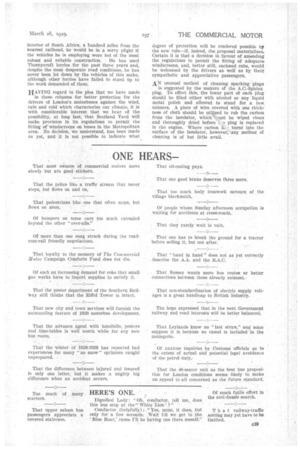VERY year statis tics are published showing the number of
Page 48

Page 49

If you've noticed an error in this article please click here to report it so we can fix it.
new vehicles put on to the road. When reading these, one naturally won ders where all the old vehicles go to when they are displaced by those of more modern construction.
A representative of this journal, while on a recent trip, saw a few solutions to the problem. In one case, a travelling showman had purchased an old 32-seater single-deck bus and is using it for carrying his spare personnel from place to place: incidentally, it was towing a caravan.
An enterprising poultry farmer had converted four one-ton van bodies of ancient date into quite presentable hen houses, whilst a third had cut up parts of a chassis and made them into upright members for supporting fence wire! dark is always rather difficult, particularly so when the vehicle is a long one with an enclosed body which cuts off the driver's view rearwards. Many men overlook the fact that certain types of spotlight which are commonly fitted to coaches and other vehicles can be turned around to face towards the back of the machine, often without having to leave the driving seat to effect the adjustment. This tip may save a good deal or paint, varnish and language.
LOCAL authorities are apparently much con cerned regarding the future of the Road Fund, and resolutions expressing this have been passed recently by over 40 local authorities. They realize that the continued raiding of this Fund is bound to exercise a repercussive effect on the roads.
THE mechanical attributes of the average _ youngster in England are recognized and his cleverness in making models of machinery with an outfit of Meccano is very often uncanny. The fact that this aptitude is not limited to kiddies of our own race is clearly shown by the accompanying illustration showing a model of a Thornyeroft six-wheeler A3-type lorry which a piccaninny in the heart of Basutoland has thought fit to knock together.
The owner of the lorry, in sending home the model, which was made by a servant of his, pays a tribute to the excellent service he has had from the six-wheeler. Situated in the interior of South Africa, a hundred miles from the nearest railhead, he would be in• a sorry plight if the vehicles he is employing were not of the most robust and reliable construction. " He has used Thornycroft lorries for the past three years and, despite the most desperate road conditions, he has never been let down by the vehicles of this make, although other lorries have failed to stand up to the work demanded of them.
HAVING regard to the plea that we have made in these columns for better protection for the drivers of London's motorbuses against the wind, rain and cold which characterize our climate, it is with considerable interest that we hear of the possibility, at long last, that Scotland Yard Will make provision in its regulations to permit the fitting of windscreens on buses in the Metropolitan area. No decision, we understand, has been made as yet, and it is not possible to indicate what degree of protection will be rendered possible by the new rule—if, indeed, the proposal materializes. Certain it is that a decision in favour of amending the regulations to permit the fitting of adequate windscreens, and, better still, enclosed cabs, would be welcomed by the drivers as well as by their sympathetic and appreciative passengers, AN unusual method of cleaning sparking plugs is suggested by the makers of the A.C.-Sphinx ping. To effect this, the lower part of each plug should be filled either with alcohol or any liquid metal polish and allowed to stand for a few: minutes. A piece of wire covered with one thickness of cloth should be utilized to rub the carbon from the insulator, which lust be wiped clean and thoroughly dried before , plug is replaced in the engine. Where carbon h. -• burnt into the surface of the insulator, however, any method of cleaning is of but little avail.




























































































































